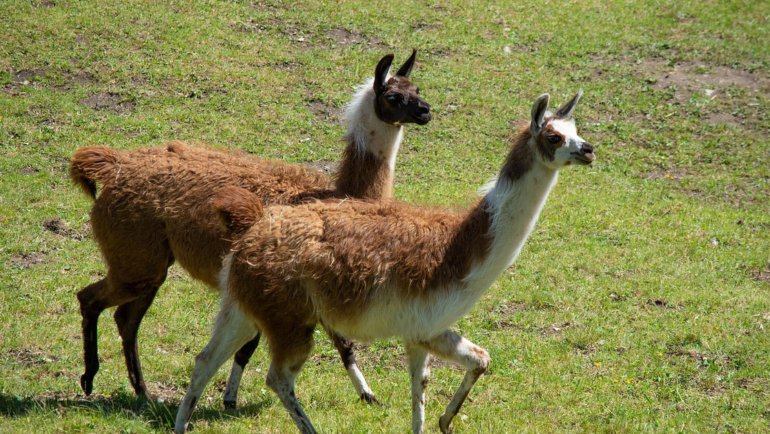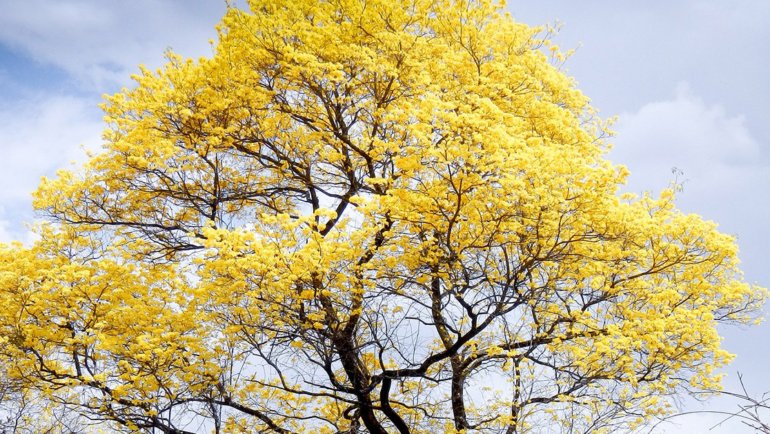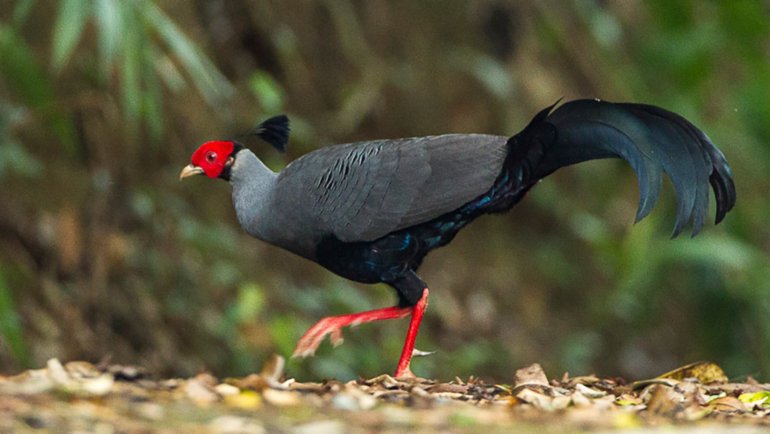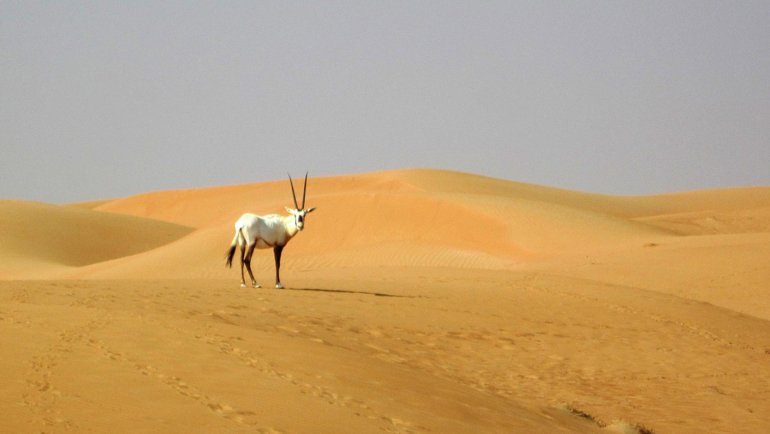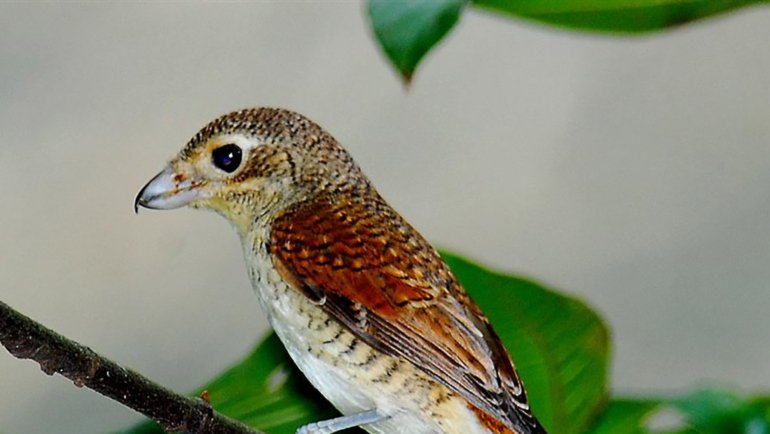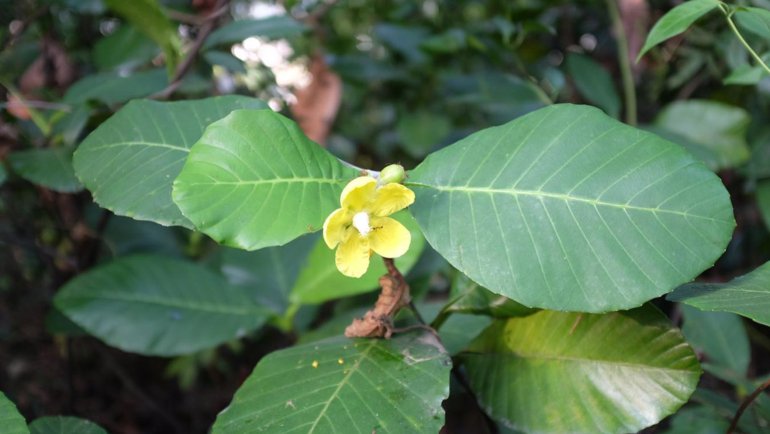Nestled between the Pacific Ocean and the Caribbean Sea, Costa Rica is a country bursting with biodiversity. From the lush rainforests to the pristine beaches, its natural beauty never ceases to amaze.
Yet, among all its wonders, there’s one creature that embodies the “pura vida” spirit of Costa Rica: the sloth. These laid-back, tree-dwelling mammals are an iconic symbol of the nation’s rich biodiversity and relaxed way of life.
But did you know that sloths only come down from trees about once a week, mainly for bathroom breaks? Dive in to discover more about these incredible creatures and their connection to the heart of Costa Rica.
Quick Info About The Sloth
| Hoffmann’s Two-Toed Sloth | Brown-Throated Three-Toed Sloth | |
| Scientific Name: | Choloepus hoffmanni | Bradypus variegatus |
| Average Size: | 21-29 inches (53-74 cm) | 18-23 inches (46-58 cm) |
| Average Weight: | 9-19 lbs (4-8.5 kg) | 5.5-8.8 lbs (2.5-4 kg) |
| Average Lifespan: | 12 years (wild), up to 20 years (captivity) | 10-15 years (wild), up to 30 years (captivity) |
| Geographical Range: | From southern Honduras to northern Colombia | From Honduras to Bolivia, including some parts of Brazil |
| Habitat: | Rainforests, cloud forests, and secondary forests | Tropical rainforests, mangroves, and cloud forests |
| Conservation Status: | Least Concern (IUCN Red List) | Least Concern (IUCN Red List) |
Meet The Sloth, National Animal of Costa Rica
A slow-paced emblem of Costa Rican wildlife, sloths are unique tree-dwelling mammals that have captured the hearts of locals and tourists alike. There are two primary types found in Costa Rica: the two-toed and three-toed sloths.
At first glance, the two types of sloths look quite similar with their sleepy expressions, sturdy bodies, and long limbs. However, a closer inspection reveals differences. Two-fingered sloths have a rounder head, larger eyes, and shaggy fur. Three-fingered sloths, on the other hand, sport a distinctive mask-like facial pattern with a mane of shorter fur around their heads and necks.
While both species have similar sizes, male three-fingered sloths often have a brighter, more distinct facial pattern. Additionally, some male three-fingered sloths have a patch on their back that can change colors during mating seasons.
One of the most notable features that differentiate the two species is their fingers or claws. The two-fingered sloth has two claws on its front limbs, while the three-fingered counterpart has three. These claws are crucial for their arboreal lifestyle, allowing them to hang comfortably from branches.
In the ecosystem, sloths play a modest yet essential role. Being herbivores, they primarily feed on leaves, fruits, and buds. This diet makes them crucial for seed dispersal, thus aiding in forest regeneration. Their slow metabolism and selective eating habits mean they don’t decimate their food sources.
In the food chain, sloths have few natural predators due to their cryptic nature and treetop habitat. However, they do face threats from eagles, jaguars, and ocelots, especially during their rare descents to the ground.
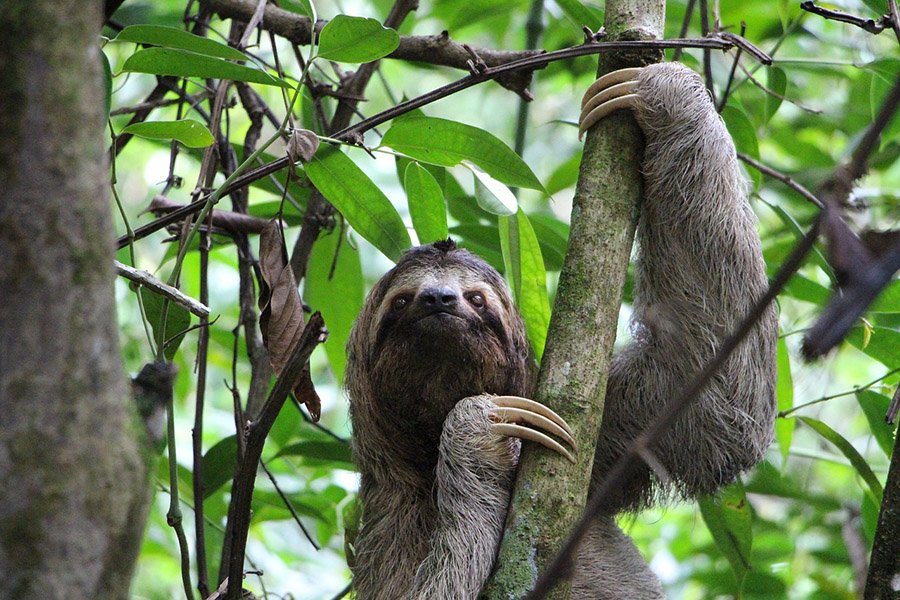
Where Do Sloths Live?
Within Costa Rica, sloths predominantly inhabit the lush rainforests, where they can be seen leisurely moving through the canopy. However, they also thrive in cloud forests, secondary forests, and even mangroves, especially the three-toed sloths.
The two-toed sloths have a geographical range that extends from southern Honduras to northern Colombia. In contrast, the three-toed sloths enjoy a broader habitat stretching from Honduras through Central America, down to Bolivia, and some parts of Brazil.
These habitats offer the sloths their preferred climates: warm, humid environments with abundant trees to provide both food and shelter. The rich biodiversity and dense canopy of these regions offer sloths protection from predators while ensuring they have access to their leafy diet. The rainforests of Costa Rica, in particular, provide an ideal setting, making the country a true paradise for these delightful creatures.
Why and When Did The Sloth Become The National Animal of Costa Rica?
In July 2021, Costa Rica officially declared both the two-fingered and three-fingered sloths as national symbols. This decision was a testament to the country’s commitment to preserving its rich biodiversity and recognizing the significance of these endearing creatures in the national culture and tourism. The sloths joined the ranks of the white-tailed deer, which had been a symbol of the country’s fauna since 1995.
Sloths symbolize a relaxed pace of life, reflecting the pura vida (“pure life”) philosophy that Costa Ricans cherish. “Pura Vida” is more than just a saying; it encapsulates the Costa Rican way of life – appreciating simple joys, living in harmony with nature, and maintaining a positive outlook. Sloths, with their leisurely pace and contented demeanor, are the perfect embodiment of this spirit.
Costa Rica, globally renowned for its biodiversity and conservation efforts, has made significant strides in promoting eco-tourism. Sloths, being among the most sought-after wildlife sightings for tourists, play an instrumental role in drawing visitors to the country’s national parks and reserves.
There haven’t been notable controversies regarding the sloths’ designation as national symbols. However, as with any decision that brings attention to a particular species, there are always concerns about increased human interactions, potentially leading to disturbances in their natural habitats.
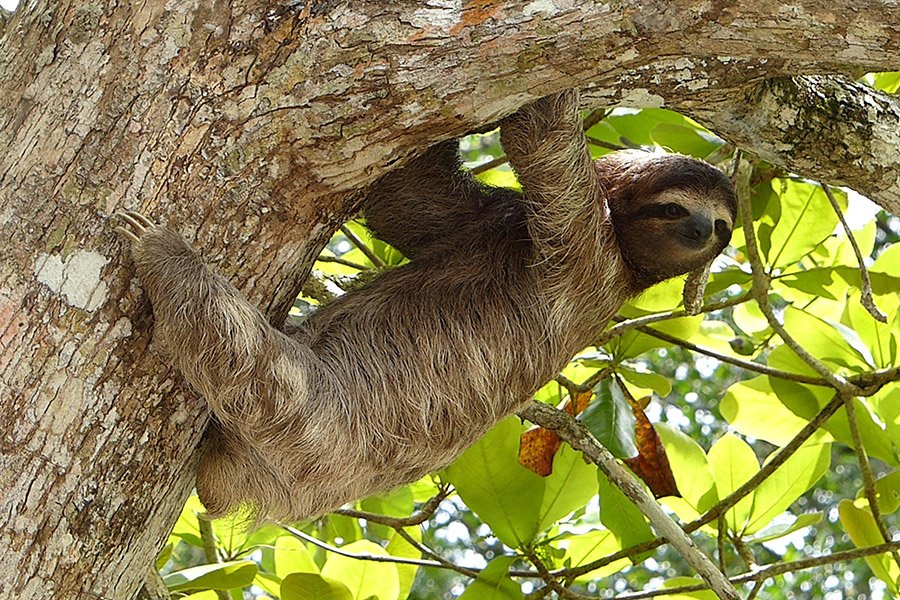
Where is The Sloth Featured in Costa Rica?
While the sloth isn’t prominently featured on official items like the national flag or banknotes, its influence permeates Costa Rican culture, especially in tourism. Sloths have become synonymous with Costa Rican wildlife, resulting in their images being used extensively in tourism brochures, souvenirs, and eco-tourism promotions.
Furthermore, many local businesses, from hostels to cafes, feature sloth motifs or names, capitalizing on the animal’s popularity among locals and tourists alike. The sloth’s significance extends beyond mere symbolism; it’s an ambassador for Costa Rica’s rich biodiversity, drawing attention to the importance of conservation and eco-friendly practices in the country.
Names of The Sloth
The two primary species of sloths recognized as national symbols in Costa Rica are the three-fingered sloth and the two-fingered sloth. These species are referred to in various ways, based on their distinct characteristics.
- Three-toed sloth:
- Scientific name: Bradypus variegatus
- Also known as: Brown-throated sloth
- In Spanish: Perezoso de tres dedos or Perezoso de garganta café
- Two-toed sloth:
- Scientific name: Choloepus hoffmanni
- Also known as: Hoffmann’s two-toed sloth
- In Spanish: Perezoso de dos dedos or Perezoso de Hoffmann
Across different cultures and languages, sloths might be referred to differently. In some indigenous cultures of Central America, sloths have been traditionally associated with sleepiness and laziness, leading to their names often being linked to these traits.
Is The Sloth Endangered?
Both the two-fingered and three-fingered sloths are not currently classified as endangered; however, they face threats from habitat destruction due to deforestation and urban development. As trees get cut down or regions become fragmented, sloths can become more vulnerable to predators or traffic accidents as they try to move from one area to another.
Conservation efforts in Costa Rica, especially given the country’s focus on eco-tourism and biodiversity protection, include the preservation of natural habitats and the establishment of biological corridors to ensure safe migration paths for animals.
Additionally, there are several sloth sanctuaries and rehabilitation centers dedicated to rescuing injured, orphaned, or displaced sloths and preparing them for reintroduction into the wild.
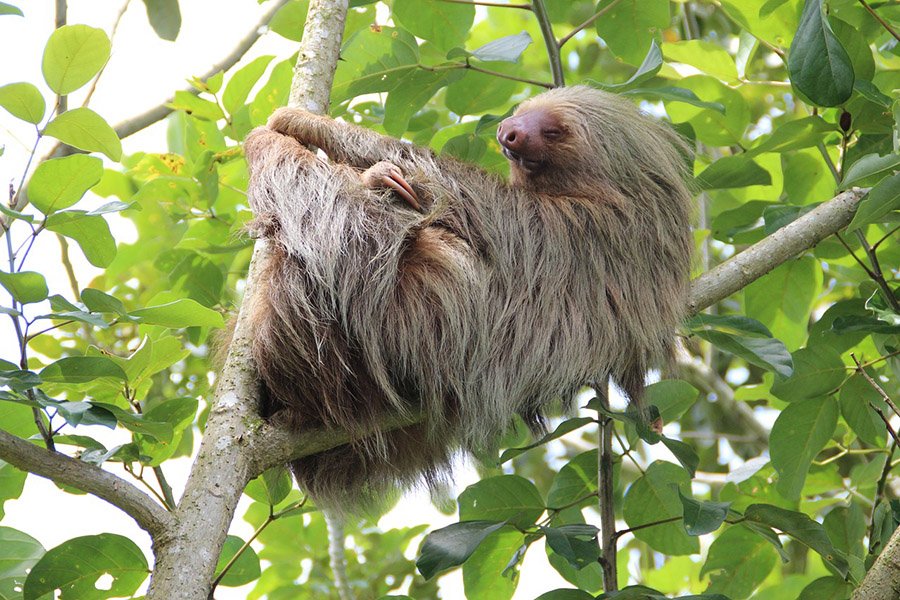
Interesting Facts About The Sloth
- Unique Digestive System: Sloths have a multi-chambered stomach and an exceptionally slow metabolic rate. It can take up to a month for them to digest a single meal!
- Ecosystem in Fur: Sloth fur is a micro-ecosystem in itself! Algae grow on their fur, which provides camouflage, and numerous insects, including moths and beetles, can be found living in it.
- Upside-down Lifestyle: Sloths spend almost their entire lives upside down: eating, sleeping, mating, and even giving birth!
- Low Energy: Their slow metabolism means they have a very low body temperature for a mammal and they move at a top speed of 0.24 kilometers per hour.
- Surprisingly Good Swimmers: Despite their slow movements on land, sloths are adept swimmers and will occasionally drop from trees into the water for a quick swim.
- Vocal Creatures: While they may seem silent, sloths can produce loud calls, especially during the mating season or when in distress.
- Built-in “Grip”: Sloths’ muscles and limbs are structured in a way that requires almost no energy to hang upside down from trees. Even deceased sloths can retain their grip and remain suspended.
- The symbiotic relationship between sloths and the algae that grows on them is noteworthy. The algae benefit from a place to live and the sloths benefit from the camouflage this provides, helping them blend into the tree canopy and evade predators. This relationship also provides a small but supplementary food source, as sloths sometimes consume the algae during grooming.
Other Beautiful Animals Native To Costa Rica
- Resplendent Quetzal: A vibrantly colored bird with striking green plumage, long tail feathers, and a crimson belly. It’s often linked with freedom as it reportedly cannot live in captivity, preferring the cloud forests of Costa Rica. It is the national bird of Guatemala.
- Strawberry Poison Dart Frog: This tiny, brightly colored amphibian is found primarily in the humid lowlands of Costa Rica. Its vibrant color warns predators of its toxicity.
- White-faced Capuchin Monkey: Known for its intelligence and distinctive appearance, the capuchin monkey is frequently spotted in Costa Rica’s national parks and reserves.
- Baird’s Tapir: The largest land mammal native to Costa Rica, the tapir is an herbivore that prefers the solitude of deep rainforests. It’s recognized by its unique trunk-like snout.
- Jaguar: The largest big cat in the Americas, the elusive jaguar roams Costa Rica’s rainforests and coastal mangroves. Their spotted coats provide excellent camouflage in the dappled sunlight of the forest floor. It is the national animal of Brazil.
Frequently Asked Questions
Why are sloths so slow?
Sloths have a very low metabolic rate, which means they burn food slowly and have less energy compared to other animals. Their specific evolutionary path prioritized the conservation of energy over agility or speed.
Are sloths native only to Costa Rica?
No, while sloths are indeed native to Costa Rica, they can also be found in various countries throughout Central and South America.
Why was the sloth chosen as the national animal of Costa Rica in 2021?
The sloth represents the peaceful and tranquil nature of Costa Rica and its people. Its designation in 2021 was a nod to the country’s rich biodiversity and commitment to environmental conservation.
How do locals in Costa Rica view sloths?
Locals often view sloths positively, associating them with the country’s rich biodiversity. Sloths are a source of pride and an embodiment of the “Pura Vida” lifestyle that emphasizes relaxation and contentment.
Are there places in Costa Rica where I can see sloths up close?
Yes, many wildlife sanctuaries and national parks in Costa Rica offer opportunities to spot sloths. There are also specific sloth sanctuaries dedicated to rescuing and rehabilitating these creatures, providing close encounters for visitors. When I visited the Monteverde Cloud Forest, there was a mother sloth with her baby, so close I could touch them.
Besides the sloth, what’s another recognized symbol of Costa Rica?
The white-tailed deer is another animal symbol of Costa Rica. It was designated as a symbol of the country’s fauna in 1995.
